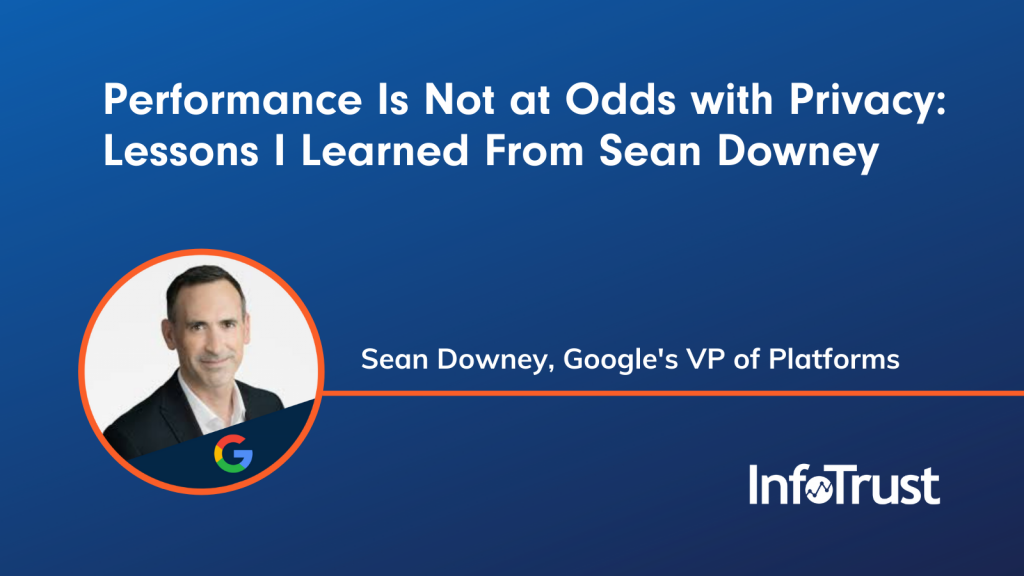In June, InfoTrust hosted a Durability Summit, where we discussed what it means to build a sustainable digital analytics marketing practice, considering all the changes that are taking place right now in the industry.
Our keynote speaker was Sean Downey, the Vice President of Platforms for the Americas at Google. He’s a twenty-year veteran of display advertising, and in his current role, Sean partners with advertisers to drive adoption and usage of technology in order to achieve their business objectives. Sean is also no stranger to InfoTrust, given that he wrote the foreword to the second edition of our book Crawl, Walk, Run: Advancing Analytics Maturity with Google Marketing Platform.
Over the course of our relationship, I’ve learned a lot from Sean’s insights into digital transformation, new technologies, and data strategies. Read on to learn what key areas, successful traits, and tools and techniques he views as essential to organizations navigating the rapidly changing landscape of digital privacy.
[Download these key takeaways as a PDF]Pay Attention to Three Key Areas
There are many changes taking place in the marketing ecosystem, and the landscape is shifting at a pace we’ve never seen before. We often hear from clients and industry professionals that these changes are overwhelming—and with good reason. The prospect of a cookieless future is disruptive, to say the least, but, as Sean shared, there are two main reasons to be optimistic:
- As we witness the erosion of consumer trust, we can tell that the change is necessary and long overdue. As chaotic as it is, this is a step in the right direction.
- It’s an exciting moment because we all have to go through it simultaneously, together. We have a great opportunity to build a coalition and define what the next 25 years of digital advertising will look like.
In order to seize that opportunity and ensure that we don’t recreate the challenges of the past, it’s imperative that we pay attention to the following areas and make them our priorities moving forward:
1. Put Consumers at the Center of Your Strategy.
Consumers want transparency, and they want a choice when it comes to how information about them will be collected and shared. If you’re doing anything that doesn’t respect your customers’ wants or needs, it won’t be sustainable. You must have a people-first strategy to protect your relationships.
Instead of trying to satisfy everyone, find ways to identify and reach the consumers who are right for your business and have the potential to generate the most revenue. Then, ask yourself, what can I do for them?
2. Think Long-Term and Respect the Opportunity that Lies Ahead.
Many of the changes that are happening right now won’t fully unfold for nine to twelve months. Some organizations think, “Great! I still have nine months, so I’ll use my same approach until the moment I can’t anymore.” There’s nothing wrong with using what’s available, but you really don’t want to delay building sustainable, long-term solutions to address your main strategic challenges.
The path of least resistance is the path without wisdom. The truth is, we’re not changing a technology policy—we’re reshaping how an ecosystem works. As Sean reminded us, our ecosystem has operated on a cookie economy since 1995. Now, it needs to be reinvented.
Don’t put a Band-Aid on a problem of this magnitude. Start thinking holistically about your people-first strategy, how you can do the right thing by customers, and start investing in long-term solutions. And do it now.
3. Cultivate a Culture of Experimentation Where it’s Okay to Fail.
We need to get comfortable with rapid innovation, experimentation, and failure. Organizations that are afraid of making mistakes won’t be able to innovate fast enough, and their fear will catch them flat-footed a year or so from now.
To be clear, when Sean talks about a culture where it’s okay to fail, he’s not encouraging recklessness. Follow the scientific method when you experiment: work with a hypothesis, test to validate that hypothesis, and then, whether it works or doesn’t, you will have learned something.
Keep in mind that experiments come in all shapes and sizes. Your experiments might consist of large tasks, like entering a new market, or small ones, like trying different Facebook messages. Over time, the cumulative information you gain from these experiments will generate huge benefits. This kind of culture takes sustained commitment. It’s a habit—not a one-time practice.
The Traits of a Successful Organization
According to Sean, “Successful digital leaders don’t just do one thing right, they do many things well repeatedly.” Successful organizations share an entire cluster of traits that help them build relationships with customers and improve their bottom line. Namely, they:
- Maintain a commitment to data and analytics across all levels of the organization.
- Constantly put new solutions to the test to determine how those solutions can benefit the business.
- Prioritize modeling and use their available data to learn what outcomes they can expect.
- Maintain strong data governance across teams and tools and commit to using customer data the right way.
- Measure their investment in analytics and how it impacts their bottom line.
- Embed analytics into the core of all marketing functions and decisions.
At InfoTrust, we’ve seen the power of these traits in our own clients. For example, we work with one of the largest B2B retailers in the US, and they’re already experimenting with server-side Tag Management, data clean rooms, and are completing a GA4 deployment. They started with conducting a risk assessment to determine what areas of their business are impacted and how, and now are beginning to experiment with new solutions to address activities that are likely to be affected the most.
Tools and Techniques
The focus of the InfoTrust Durability Summit was adapting to changes and building an analytics practice that will stand the test of time. So, I asked Sean what the model digital analytics practice looks like and what tools and techniques organizations can leverage to help themselves succeed.
Sean explained that Google’s guiding principle is to invest in privacy-preserving technology, and they believe this can be done through three key pillars:
- Use first-party data. There is no replacement for having a great relationship with your customers. Lean into first-party relationships where customers have consented to share their data, and build a strategy for enhancing your connection with your most valuable customers.
- Leverage automation, machine learning, and cloud solutions. This will allow you to build on your insights to drive and measure performance, whether through automated targeting, smart-bidding, or conversion modeling. There are tremendous amounts of advancements in modern technology that drive performance as well as, if not better than, one-to-one targeting.
- Test the efficacy and effectiveness of privacy-preserving APIs, such as Google’s Privacy Sandbox. Through the Privacy Sandbox initiative, Chrome is aiming to proactively reconstruct the ecosystem from the ground up in a privacy-forward way. This is being accomplished by building functionality in privacy-preserving APIs to solve key web and ads use cases without relying on identifying information about individual users. The APIs will maintain a user’s data locally on their browser, only sharing it in aggregated form and with a time lag. According to Sean, “From what we’ve seen from some early experiments, the privacy sandbox APIs have the potential to deliver comparable performance to existing user-level identifiers.”
These are three actionable items your organization can do to excel in the ever-changing privacy landscape. I would like to add two more items to the list:
- Prioritize data governance. Having a great relationship with your customer is predicated on how much they trust you to use their data the right way. Focus on building processes within your organization to minimize any risk of customer data being compromised.
- Build a solid roadmap using Google’s Durable Five. Google’s Durable Five toolkit includes five resources that help organizations build an effective technology stack. These include:
- Google Analytics 4 dual tagging
- One Google tag
- Enhanced conversions
- Automated targeting
- Customer match
Performance Is Not at Odds with Privacy
Obviously, Sean taught us a lot during his keynote talk, but one of the most powerful takeaways I learned from him was this: Performance is not at odds with privacy. Contrary to what many marketers may believe, performance is not predicated solely on one-to-one precision targeting. Advances in aggregation, anonymization, on-device processing, and other privacy-preserving technologies show a clear path away from individual identifiers.
In Sean’s words, “While we might not have all the answers at the moment, we’re excited to take advantage of modern marketing science and experiment with new and existing strategies to help prove to the industry that performance and privacy can go hand-in-hand. We all have a role to play in proving this and creating a better environment for everyone to thrive.”










